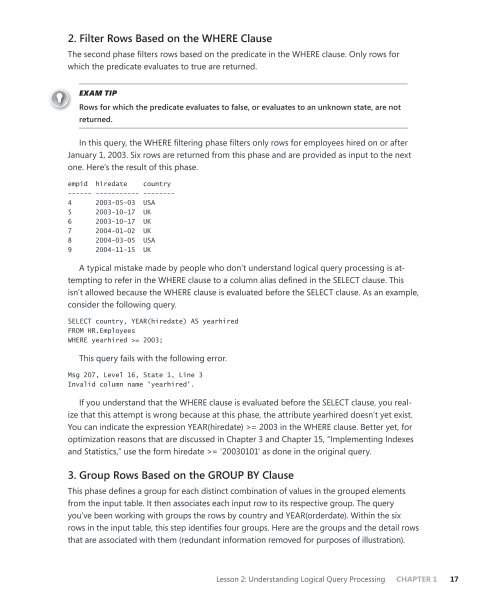Training Kit (Exam 70-461): Querying Microsoft ... - Cdn.oreilly.com
Training Kit (Exam 70-461): Querying Microsoft ... - Cdn.oreilly.com
Training Kit (Exam 70-461): Querying Microsoft ... - Cdn.oreilly.com
You also want an ePaper? Increase the reach of your titles
YUMPU automatically turns print PDFs into web optimized ePapers that Google loves.
2. Filter Rows Based on the WhERE Clause<br />
The second phase filters rows based on the predicate in the WHERE clause. Only rows for<br />
which the predicate evaluates to true are returned.<br />
<strong>Exam</strong> Tip<br />
Rows for which the predicate evaluates to false, or evaluates to an unknown state, are not<br />
returned.<br />
In this query, the WHERE filtering phase filters only rows for employees hired on or after<br />
January 1, 2003. Six rows are returned from this phase and are provided as input to the next<br />
one. Here’s the result of this phase.<br />
empid hiredate country<br />
------ ----------- --------<br />
4 2003-05-03 USA<br />
5 2003-10-17 UK<br />
6 2003-10-17 UK<br />
7 2004-01-02 UK<br />
8 2004-03-05 USA<br />
9 2004-11-15 UK<br />
A typical mistake made by people who don’t understand logical query processing is attempting<br />
to refer in the WHERE clause to a column alias defined in the SELECT clause. This<br />
isn’t allowed because the WHERE clause is evaluated before the SELECT clause. As an example,<br />
consider the following query.<br />
SELECT country, YEAR(hiredate) AS yearhired<br />
FROM HR.Employees<br />
WHERE yearhired >= 2003;<br />
This query fails with the following error.<br />
Msg 207, Level 16, State 1, Line 3<br />
Invalid column name 'yearhired'.<br />
If you understand that the WHERE clause is evaluated before the SELECT clause, you realize<br />
that this attempt is wrong because at this phase, the attribute yearhired doesn’t yet exist.<br />
You can indicate the expression YEAR(hiredate) >= 2003 in the WHERE clause. Better yet, for<br />
optimization reasons that are discussed in Chapter 3 and Chapter 15, “Implementing Indexes<br />
and Statistics,” use the form hiredate >= '20030101' as done in the original query.<br />
3. Group Rows Based on the GROUp BY Clause<br />
This phase defines a group for each distinct <strong>com</strong>bination of values in the grouped elements<br />
from the input table. It then associates each input row to its respective group. The query<br />
you’ve been working with groups the rows by country and YEAR(orderdate). Within the six<br />
rows in the input table, this step identifies four groups. Here are the groups and the detail rows<br />
that are associated with them (redundant information removed for purposes of illustration).<br />
Lesson 2: Understanding Logical Query Processing chapter 1 17
















